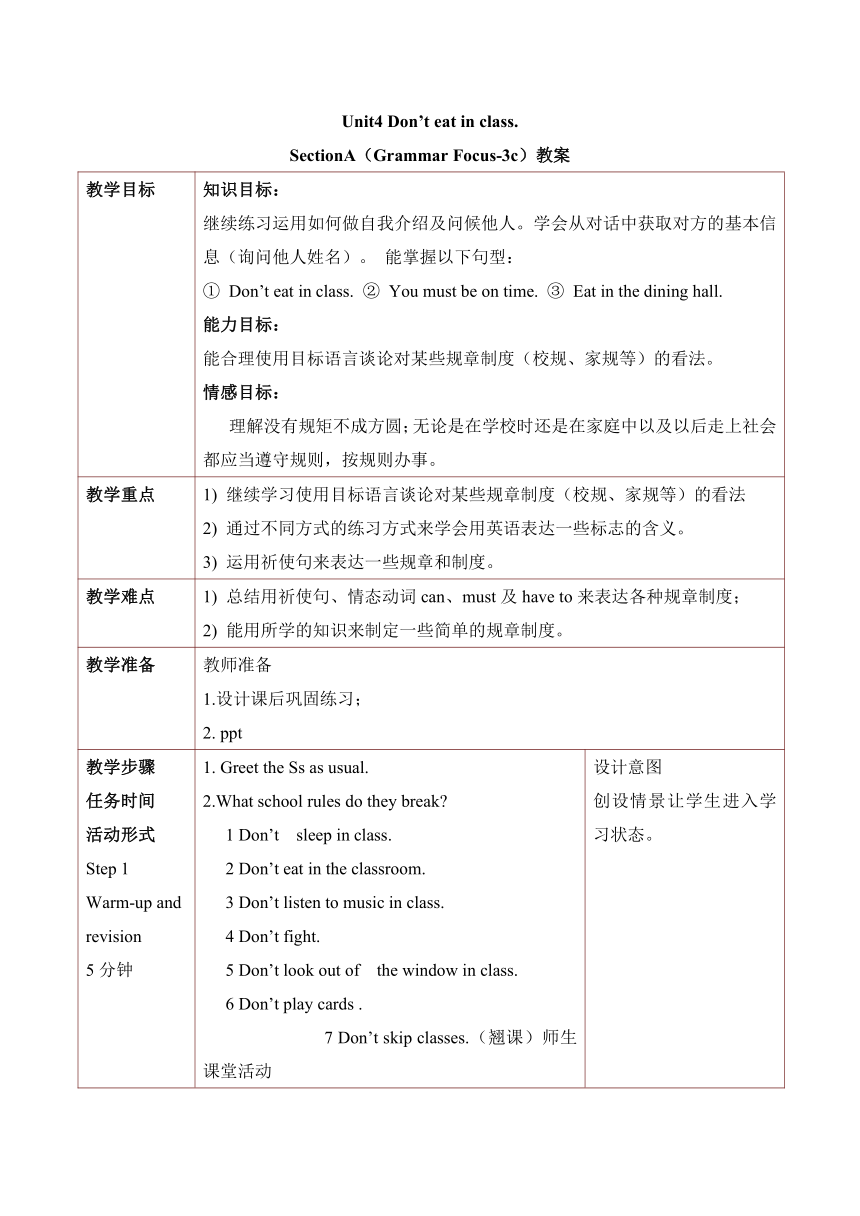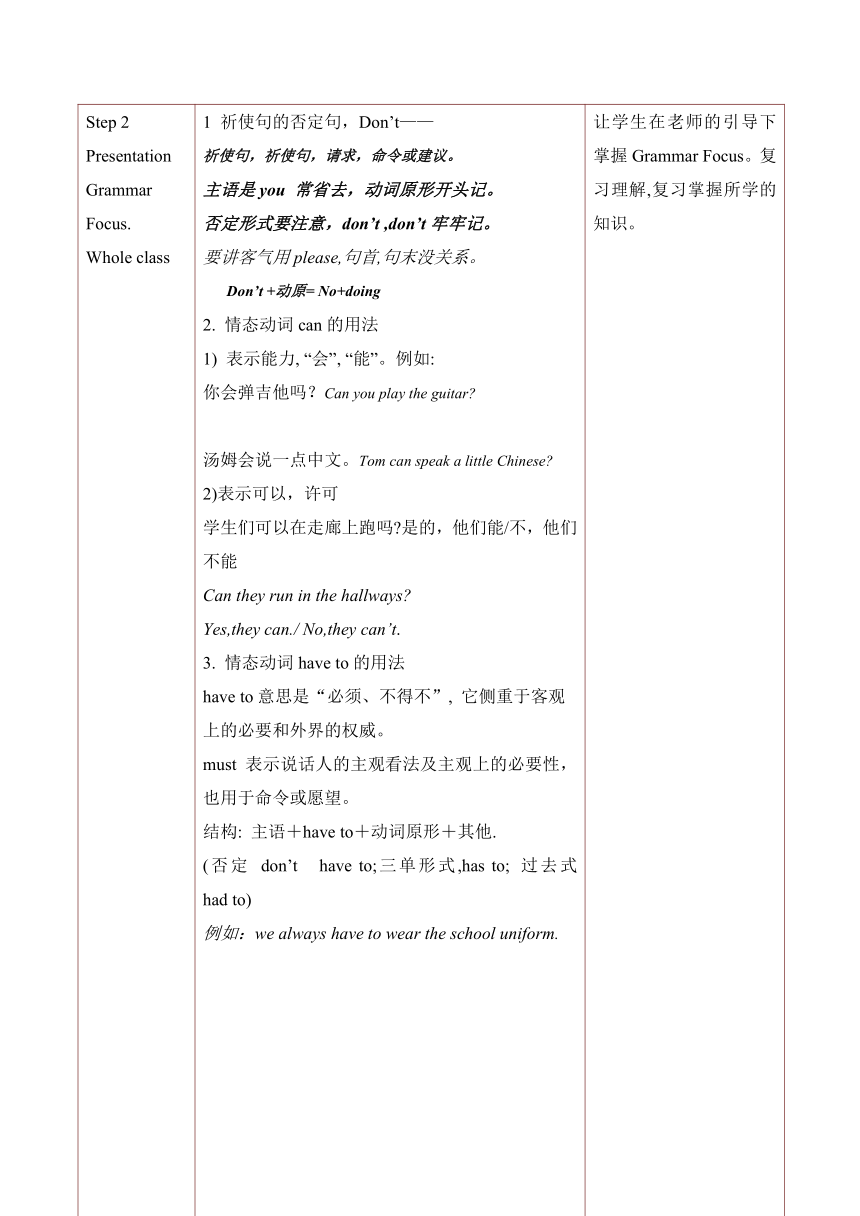人教版七年级下册 Unit4 Don't eat in class. SectionA Grammar Focus-3c 教案(表格式)
文档属性
| 名称 | 人教版七年级下册 Unit4 Don't eat in class. SectionA Grammar Focus-3c 教案(表格式) |

|
|
| 格式 | doc | ||
| 文件大小 | 50.0KB | ||
| 资源类型 | 教案 | ||
| 版本资源 | 人教新目标(Go for it)版 | ||
| 科目 | 英语 | ||
| 更新时间 | 2022-12-13 09:37:35 | ||
图片预览


文档简介
Unit4 Don’t eat in class.
SectionA(Grammar Focus-3c)教案
教学目标 知识目标:继续练习运用如何做自我介绍及问候他人。学会从对话中获取对方的基本信息(询问他人姓名)。 能掌握以下句型:① Don’t eat in class. ② You must be on time. ③ Eat in the dining hall.能力目标:能合理使用目标语言谈论对某些规章制度(校规、家规等)的看法。情感目标:理解没有规矩不成方圆;无论是在学校时还是在家庭中以及以后走上社会都应当遵守规则,按规则办事。
教学重点 1) 继续学习使用目标语言谈论对某些规章制度(校规、家规等)的看法2) 通过不同方式的练习方式来学会用英语表达一些标志的含义。3) 运用祈使句来表达一些规章和制度。
教学难点 1) 总结用祈使句、情态动词can、must及have to来表达各种规章制度;2) 能用所学的知识来制定一些简单的规章制度。
教学准备 教师准备1.设计课后巩固练习;2. ppt
教学步骤任务时间活动形式Step 1 Warm-up andrevision5分钟 1. Greet the Ss as usual. 2.What school rules do they break 1 Don’t sleep in class. 2 Don’t eat in the classroom.3 Don’t listen to music in class.4 Don’t fight.5 Don’t look out of the window in class.6 Don’t play cards .7 Don’t skip classes.(翘课)师生课堂活动 设计意图创设情景让学生进入学习状态。
Step 2PresentationGrammar Focus. Whole class 1 祈使句的否定句,Don’t——祈使句,祈使句,请求,命令或建议。 主语是you 常省去,动词原形开头记。 否定形式要注意,don’t ,don’t牢牢记。 要讲客气用please,句首,句末没关系。 Don’t +动原= No+doing2. 情态动词can的用法1) 表示能力, “会”, “能”。例如:你会弹吉他吗?Can you play the guitar 汤姆会说一点中文。Tom can speak a little Chinese 2)表示可以,许可学生们可以在走廊上跑吗 是的,他们能/不,他们不能Can they run in the hallways Yes,they can./ No,they can’t. 3. 情态动词have to的用法have to意思是“必须、不得不”, 它侧重于客观上的必要和外界的权威。must 表示说话人的主观看法及主观上的必要性,也用于命令或愿望。结构: 主语+have to+动词原形+其他. (否定 don’t have to;三单形式,has to; 过去式had to) 例如:we always have to wear the school uniform. 让学生在老师的引导下掌握Grammar Focus。复习理解,复习掌握所学的知识。
Step 3Practice组织对话 5分钟3a Whole class3b Pair work3c Whole class 处理3a,3b和3c 1. Work on 3a:① Look at 3a. Do you know the meaning of these pictures Yeah, you see them in the school library. Can you write the rules for the school library ② Ss discuss the pictures and make some rules.③ Let some Ss read their rules aloud. ④ Check the answers with the class. (Don’t listen to music in the library. Don’t eat or drink in the library. Don’t take photos in the library. )2.Work on 3b:① T: Use the words to make questions about the rules. Then write answers according to your school. For example:Be quiet (she/have to/ in the library)Does she have to be quiet in the library Yes, she does. ② 注意: have to虽是情态动词,但其在句子中与谓语动词共同构成句子时,其一般疑问句应用助动词do或does来帮助构成;而情态动词can则直接提前构成一般疑问句式。③ Ss work by themselves and try to write the sentences on the workbook. ④ Ss work in pairs. Ask and answer the sentences. 3.Work on 3c: Game ① Everybody has a dream school. Suppose you’re the headmaster of the Coolest School. You can make rules for your school. Make up five cool rules for your dream school. ② Ss work in groups and discuss what rules are in their school.③ Write down their rules on the work. ④ Let some Ss read their rules aloud. ⑤ See whose school is the coolest 学生通过先自己思考,到小组讨论,再到自我总结列出图书馆的规章制度。在此基础上在,学生根据不同情境进行对话,熟练运用目标语言。最后,通过梦想中的学校这环节发挥学生创造力,打开学生思路,也对学生的纪律观进行引导。
Step 4 ConsolidationWhole class If time is enough, do some more exercises on the screen.使用ppt呈现。 让学生巩固本课的知识。
板书设计可以用ppt 替代。 Section A Grammar Focus-3c一、 Sentences:1. —Can we wear a hat in the classroom —Yes, we can. / No, we can’t. 2. —Does she have to wear a uniform at school —Yes, he does. No, he doesn’t.二、3b:1. Does he have to eat in the dinning hall Yes, he does.2. Can we listen to music in the hallways Yes, we can. 3. Can we wear a hat in the classroom No, we can’t.
SectionA(Grammar Focus-3c)教案
教学目标 知识目标:继续练习运用如何做自我介绍及问候他人。学会从对话中获取对方的基本信息(询问他人姓名)。 能掌握以下句型:① Don’t eat in class. ② You must be on time. ③ Eat in the dining hall.能力目标:能合理使用目标语言谈论对某些规章制度(校规、家规等)的看法。情感目标:理解没有规矩不成方圆;无论是在学校时还是在家庭中以及以后走上社会都应当遵守规则,按规则办事。
教学重点 1) 继续学习使用目标语言谈论对某些规章制度(校规、家规等)的看法2) 通过不同方式的练习方式来学会用英语表达一些标志的含义。3) 运用祈使句来表达一些规章和制度。
教学难点 1) 总结用祈使句、情态动词can、must及have to来表达各种规章制度;2) 能用所学的知识来制定一些简单的规章制度。
教学准备 教师准备1.设计课后巩固练习;2. ppt
教学步骤任务时间活动形式Step 1 Warm-up andrevision5分钟 1. Greet the Ss as usual. 2.What school rules do they break 1 Don’t sleep in class. 2 Don’t eat in the classroom.3 Don’t listen to music in class.4 Don’t fight.5 Don’t look out of the window in class.6 Don’t play cards .7 Don’t skip classes.(翘课)师生课堂活动 设计意图创设情景让学生进入学习状态。
Step 2PresentationGrammar Focus. Whole class 1 祈使句的否定句,Don’t——祈使句,祈使句,请求,命令或建议。 主语是you 常省去,动词原形开头记。 否定形式要注意,don’t ,don’t牢牢记。 要讲客气用please,句首,句末没关系。 Don’t +动原= No+doing2. 情态动词can的用法1) 表示能力, “会”, “能”。例如:你会弹吉他吗?Can you play the guitar 汤姆会说一点中文。Tom can speak a little Chinese 2)表示可以,许可学生们可以在走廊上跑吗 是的,他们能/不,他们不能Can they run in the hallways Yes,they can./ No,they can’t. 3. 情态动词have to的用法have to意思是“必须、不得不”, 它侧重于客观上的必要和外界的权威。must 表示说话人的主观看法及主观上的必要性,也用于命令或愿望。结构: 主语+have to+动词原形+其他. (否定 don’t have to;三单形式,has to; 过去式had to) 例如:we always have to wear the school uniform. 让学生在老师的引导下掌握Grammar Focus。复习理解,复习掌握所学的知识。
Step 3Practice组织对话 5分钟3a Whole class3b Pair work3c Whole class 处理3a,3b和3c 1. Work on 3a:① Look at 3a. Do you know the meaning of these pictures Yeah, you see them in the school library. Can you write the rules for the school library ② Ss discuss the pictures and make some rules.③ Let some Ss read their rules aloud. ④ Check the answers with the class. (Don’t listen to music in the library. Don’t eat or drink in the library. Don’t take photos in the library. )2.Work on 3b:① T: Use the words to make questions about the rules. Then write answers according to your school. For example:Be quiet (she/have to/ in the library)Does she have to be quiet in the library Yes, she does. ② 注意: have to虽是情态动词,但其在句子中与谓语动词共同构成句子时,其一般疑问句应用助动词do或does来帮助构成;而情态动词can则直接提前构成一般疑问句式。③ Ss work by themselves and try to write the sentences on the workbook. ④ Ss work in pairs. Ask and answer the sentences. 3.Work on 3c: Game ① Everybody has a dream school. Suppose you’re the headmaster of the Coolest School. You can make rules for your school. Make up five cool rules for your dream school. ② Ss work in groups and discuss what rules are in their school.③ Write down their rules on the work. ④ Let some Ss read their rules aloud. ⑤ See whose school is the coolest 学生通过先自己思考,到小组讨论,再到自我总结列出图书馆的规章制度。在此基础上在,学生根据不同情境进行对话,熟练运用目标语言。最后,通过梦想中的学校这环节发挥学生创造力,打开学生思路,也对学生的纪律观进行引导。
Step 4 ConsolidationWhole class If time is enough, do some more exercises on the screen.使用ppt呈现。 让学生巩固本课的知识。
板书设计可以用ppt 替代。 Section A Grammar Focus-3c一、 Sentences:1. —Can we wear a hat in the classroom —Yes, we can. / No, we can’t. 2. —Does she have to wear a uniform at school —Yes, he does. No, he doesn’t.二、3b:1. Does he have to eat in the dinning hall Yes, he does.2. Can we listen to music in the hallways Yes, we can. 3. Can we wear a hat in the classroom No, we can’t.
同课章节目录
- Unit 1 Can you play the guitar?
- Section A
- Section B
- Unit 2 What time do you go to school?
- Section A
- Section B
- Unit 3 How do you get to school?
- Section A
- Section B
- Unit 4 Don't eat in class.
- Section A
- Section B
- Unit 5 Why do you like pandas?
- Section A
- Section B
- Unit 6 I'm watching TV.
- Section A
- Section B
- Review of Units 1-6
- Unit 7 It's raining!
- Section A
- Section B
- Unit 8 Is there a post office near here?
- Section A
- Section B
- Unit 9 What does he look like?
- Section A
- Section B
- Unit 10 I'd like some noodles.
- Section A
- Section B
- Unit 11 How was your school trip?
- Section A
- Section B
- Unit 12 What did you do last weekend?
- Section A
- Section B
